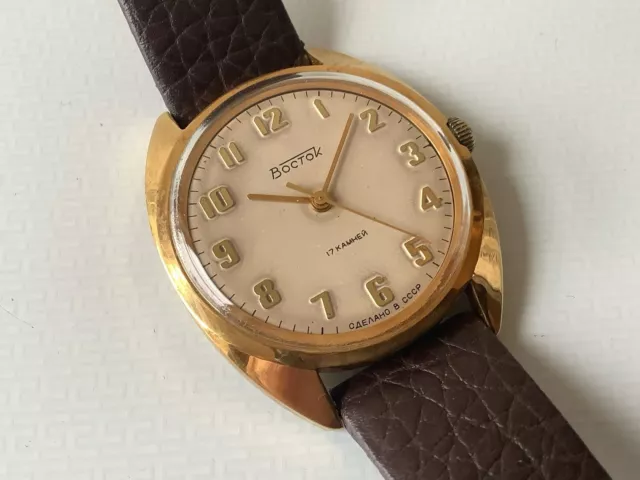1970s Vostok with Vostok 2409A (17 jewels) manual movement
1970s Vostok [model 763570] with a Vostok 2409A (17 jewels) manual, i.e. hand wind, movement which runs at 18,000 bph/5 'ticks' per second. The movement is stamped with 624303 below the balance wheel along with the (from 1964) Восток (i.e. Vostok) logo and 2409A is stamped on the bridge. The gold plated brass case houses a white dial (with a heavy, but aesthetic patina) and raised gold coloured Arabic indices and gold coloured hands. Восток (i.e. Vostok) is printed in black below 12 o’clock with 17 камней (meaning 17 jewels) above 6 o’clock. Сделано в CCCP (meaning Made in CCCP) is below 6 o’clock. The stainless steel screw case back is stamped with SHOCKPROOF BALANCE and DUST-PROOF. The watch is fitted on a barely worn vintage-style brown buffalo grain thin leather strap with a gold coloured buckle which suits this timepiece perfectly. The acrylic crystal is free of any significant marks and overall the watch itself is in nice vintage condition, entirely commensurate with its age. This collectible working timepiece keeps good time with a reassuring tick and accuracy falls easily within Vostok’s stated tolerances (between -20/+60 seconds a day) .
Approximate dimensions of case: diameter 35mm (excluding crown), lug to lug 41mm, thickness 8mm (including crystal).
About the watch brand:
Vostok (Russian: Восток, meaning "East") is a Russian watchmaker based in Chistopol, Tatarstan. The Vostok Watch Makers company was founded in 1942 when one of the Moscow watch-making plants of the First Moscow Watch Factory was evacuated to Chistopol, a small town located on the Kama River in Tatarstan, Russia. Only defence equipment was produced during the war years, but as soon as the war was over the company started making mechanical wrist watches. As Chistopol was the Ministry of Defence’s official watchmaker beginning in 1965, Vostok watches were built for harsh field conditions. As a consequence of the 1960s Russian space programme all watches produced by the factory have had the same “Восток” (literally meaning East in Russian) brand name and the company itself was renamed Chistopol Watch Factory Восток. They created their world famous “Komandirskie” (Commander) range of watches in 1965 and the experience gained through development of the army watch led to the Amphibia range, a stainless-steel diving watch able to withstand a 200 metre depth, which was released in 1967.
Throughout the 1980s there was a sharp decline in quality, fit, and finish of nearly all Soviet watches. These signs of deteriorating quality continued until the eventual collapse of the Soviet Union in 1991. In 1986, toward the end of the Cold War, the Vostok watch factory at Chistopol was transferred from the Ministry of Instrument Engineering to the Ministry of Radio Industry. While more publicly known for the production of affordable watches and watch movements, Vostok was actually a labyrinth of departments during the Soviet era, many of which were engaged in activities for the electronic equipment needs of the Soviet military aviation and space programs. 70% of the production by Vostok was military electronics in actual fact, not watches. After the Soviet Union collapsed Vostok went into a long period of decline although they continued to make watches. Despite numerous incredible feats of engineering success, the gradual fall of the USSR (1988-1991) hit Vostok quite hard.
In 1992, a young Lithuanian physicist named Igor Zubovskij was working with his team under classified Soviet directives at the Vilnius Radio Measurement Equipments Research Institute in Lithuania on a critical piece of a Soviet government contract. The project, a microwave transceiver being built together with and for the Vostok factory at Chistopol in Tatarstan, had been approaching completion when the Soviet Union rapidly collapsed. Lithuania and the former Soviet republics quickly fell into chaos. Vostok watch factory owed the team money for the work already completed, but they were unable to transfer money because the banking system had collapsed. So, instead of money, the chief of laboratory at Vostok paid the team with Vostok Komandirskie watches which they sold for cash on a street market. As the team of scientists and engineers were not going to be able to make money from microwave electronics anymore they decided to do so from watches. This was the genesis of a new watch business and Vostok-Europe was soon to be born. ‘Koliz Laikrodžiai’ (Koliz Watches) was formed as a result of the fledgling company from Lithuania signing an agreement with Chistopol Watch Factory to create a new brand of watches, called Vostok-Europe, in August of 2003. The main goal of both companies was the creation of a new series of high quality watches, combining modern watch design with Vostok movements produced by Chistopol Watch Factory. Vostok Watch Makers and Koliz Watches agreed to develop two movements exclusively for Vostok-Europe watches. The production of movements 2426 and 2432 was started by Runim (part of Chistopol Watch Factory) in May of 2004. All the namesakes for the watch models that are produced by Vostok-Europe come from Russian or Eastern European historic, scientific or technological achievements. Each watch maker at Vostok-Europe can complete 15 to 20 pieces per day depending on the complexity of the movement and the case and materials of the watch. Simple mathematics determines that Vostok Europe is a boutique brand focused on quality over quantity with a maximum of 25 to 30,000 watches per year passing through the hands of their skilled watch technicians. This is a fraction of the amount that larger watch companies are able to produce. Vostok-Europe are classified as being at the lower end of the luxury watch scale.
Chistopol Watch Factory continued to produce their Восток brand watches whilst also supplying watch movements for Vostok-Europe. However, Vostok Watch Makers subsequently filed for bankruptcy in early 2010 and their official web page was disabled. Despite this, watch production did not stop and they eventually managed to reorganise themselves in 2013 with a new company name of CJSC ChChZ “Vostok” (Closed Joint-Stock Company Chistopol City Watch Factory "Vostok"). The cooperation between Vostok and Vostok-Europe lasted 11 years, up to 2014, when the import of movements from Russia finally stopped. In recent years, Vostok has partially regained its footing and Chistopol is one of the few remaining Soviet watch factories. Today, Vostok and Vostok-Europe are two different watch companies. One is original Восток brand that still manufactures watches at Chistopol with Russian movements and the other (Vostok-Europe) is a brand of watches produced by Lithuanian company Koliz Watches, now using Miyota and Seiko movements from Japan.
Variations of the Vostok name:
The proper English transliteration of Восток is Vostok, but during the Soviet era watches for the domestic Russian market were branded Восток and the export versions were branded Wostok. The reason for this was because watches destined for export were mainly to Warsaw Pact countries, expecially to the GDR where the German transliteration of the Cyrillic ‘B’ is ‘W’, not ‘V’ as in English. The same was true in Ukraine which also uses the Cyrillic alphabet. Whilst Ukrainian is similar to Russian, it is a separate language and the Cyrillic ‘B’ is usually transliterated to ‘W’. Following the demise of the Soviet Union, all watches produced at Chistopol have become known more commonly by their English (i.e. Vostok) name.
About the movement:
The Vostok 2409 and Vostok 2409A were the simplest versions of the standard Vostok mechanical caliber series. They both had a lever construction, an indirect centre second, a Glucydur balance and featured seventeen jewels. The adjustable hairspring connector and the long regulator is remarkable and allows a precise adjustment of the movement. According to a Vostok catalogue from 1974, the main difference between Vostok 2409 and 2409A was that the former one was of 2nd class accuracy, while the latter was 1st class. Also, the 2409 had 40 hours of power reserve, whereas 2409A had 46 hours.
- Condition: Used
- Strap Material: Leather
- Closure: Buckle
- Strap Colour: Brown
- Number of Jewels: 17 Jewels
- Indices: Arabic Numerals
- Dial Colour: White
- Year Manufactured: 1970-1979
- Customised: No
- Band/Strap: Two-Piece Strap
- Vintage: Yes
- Case Thickness: 8 mm
- Department: Men, Women, Unisex Adults
- Case Colour: Gold
- Caseback: Screwback
- Lug Width: 18 mm
- Escapement Type: Lever
- Watch Shape: Round
- Style: Classic
- Features: 12-Hour Dial, Acrylic Crystal, Seconds Hand, Shock-Resistant, Push/Pull Crown
- Case Size: 35 mm
- Case Material: Gold Plated, Brass
- Caliber & Type: Vostok 2409A (17 jewels) manual
- Movement: Mechanical (Manual)
- Water Resistance: Unknown - Not Tested
- With Papers: No
- Brand: Vostok
- Type: Wristwatch
- Model: 763570
- With Original Box/Packaging: No
- Case Finish: Polished
- With Manual/Booklet: No
- Country/Region of Manufacture: Russian Federation
- Display: Analogue
PicClick Insights - 1970s Vostok with Vostok 2409A (17 jewels) manual movement PicClick Exclusive
- Popularity - 6 watchers, 0.5 new watchers per day, 13 days for sale on eBay. Super high amount watching. 0 sold, 1 available.
- Best Price -
- Seller - 787+ items sold. 0% negative feedback. Great seller with very good positive feedback and over 50 ratings.
People Also Loved PicClick Exclusive
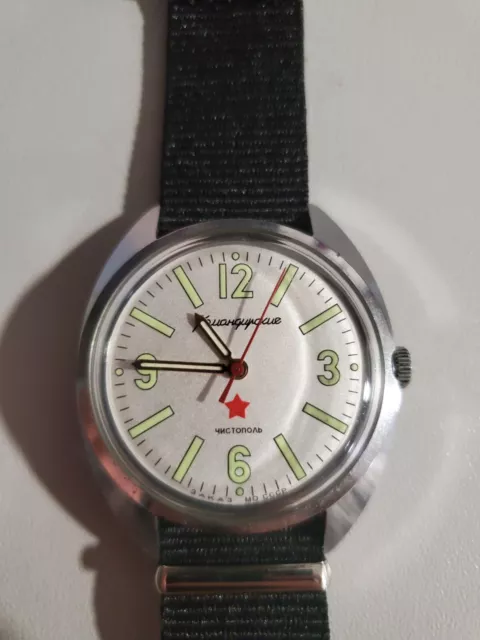
Vintage Soviet Watch Vostok Komandirskie Luminous Dial USSR Wristwatch 1970s
£90.00 Buy It Now 17d 9h
Vostok (Boctok) Yuri Gagarin Wristwatch
£40.00 Buy It Now 7d 5h
Vostok mens 41mm watch Komandirskie Russian mechanical wristwatch working Boctok
£45.00 Buy It Now 23d 15h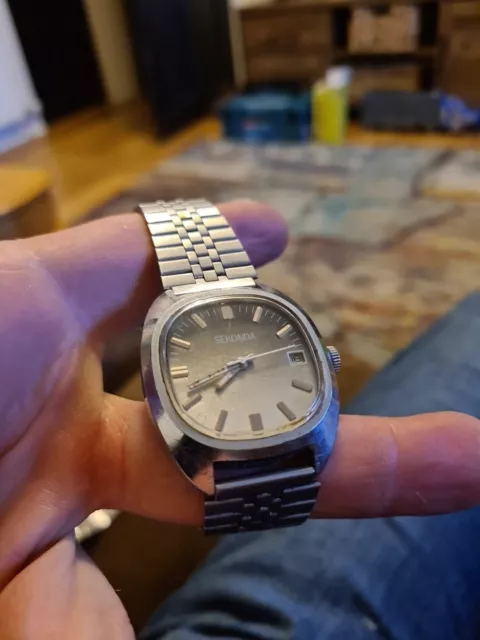
VINTAGE SEKONDA Date 17 JEWELS HAND-WINDING GENT'S WATCH
£28.00 Buy It Now 24d 9h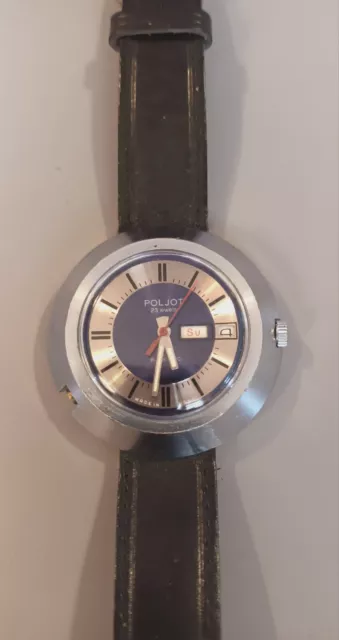
Vintage POLJOT Blue Ufo Automatic Watch Russian USSR Working Order Leather Strap
£90.00 0 Bids 4d 8h
Vostok Vintage 70's Mechanical Working Watch For Men Soviet With Leather Strap
£125.30 Buy It Now or Best Offer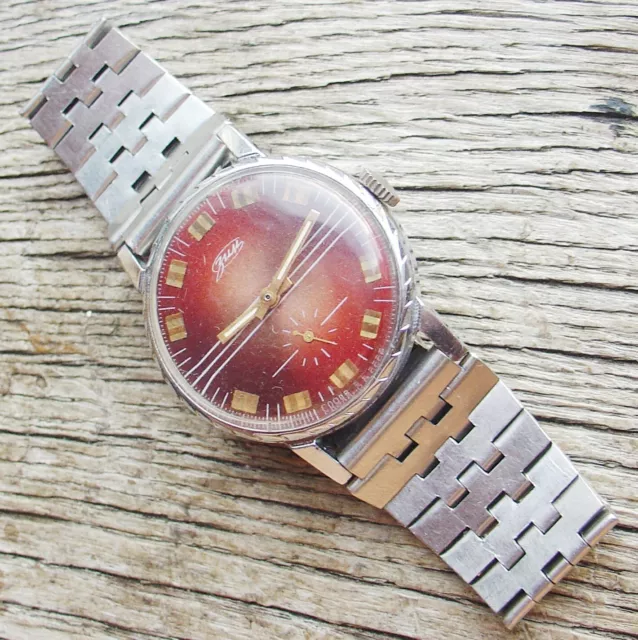 5 watchers
5 watchersRARE SOVIET ZIM (POBEDA) 2602 WATCH RED DIAL with Bracelet ZIM
£43.37 Buy It Now or Best Offer 2 watchers
2 watchersVintage Serviced Mechanical Vostok Men's Dress Watch With Black Leather Strap
£134.93 Buy It Now or Best Offer
Vostok Vintage Mechanical Dress Watch For Men Soviet Watch With Metal Bracelet
£115.66 Buy It Now or Best Offer
